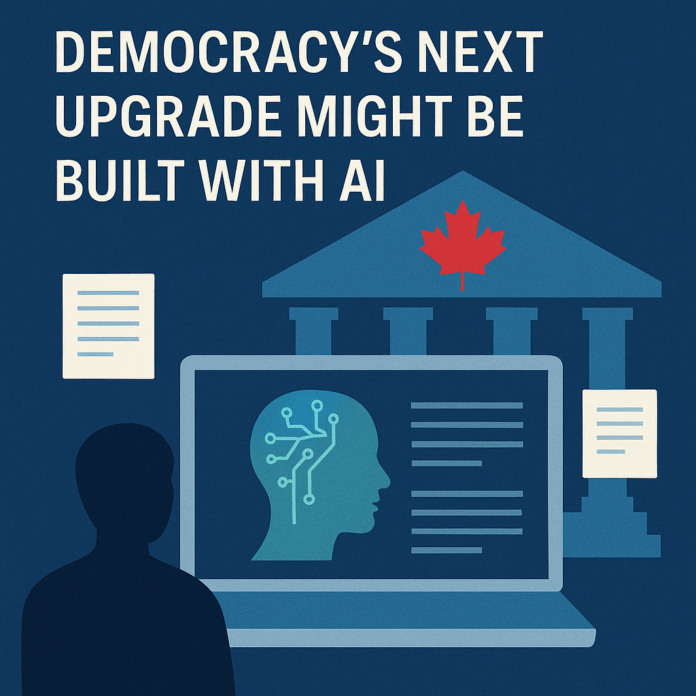For decades, Canadians have been told that we live in one of the world’s strongest democracies. We vote, we debate, we hold governments accountable — at least in theory. But anyone who’s ever tried to influence a federal bill or shape public policy knows how hollow that promise can feel. Most legislation moves from introduction to royal assent with minimal public input, shaped primarily by cabinet priorities, party discipline, and professional lobbyists who understand how the system works.
That democratic disconnect isn’t because people don’t care. It’s because most Canadians don’t have the time, expertise, or access to meaningfully participate in the legislative process. Reading a 200-page bill, decoding the legalese, tracking amendments, and writing a submission that meets committee standards is a full-time job. And unless you’re part of a well-funded advocacy group, you’re unlikely to have the resources or connections to do it.
But what if that changed?
What if artificial intelligence — the same technology that’s transforming industries and workplaces — could also transform the relationship between citizens and their government? What if we could automate the hardest parts of legislative engagement and give ordinary Canadians the tools to participate directly in shaping the laws that govern them?
That’s not science fiction. It’s entirely possible. And if we build it right, it could fundamentally alter how Canadian democracy operates.
The Problem With Participation Today
Let’s start with a hard truth: most Canadians have almost no direct influence on federal legislation beyond casting a ballot every few years.
Yes, parliamentary committees technically accept public submissions. Yes, anyone can write their MP. And yes, there are online consultations from time to time. But in practice, these channels are difficult to navigate and dominated by well-organized groups with legal, policy, or lobbying teams.
The average Canadian doesn’t stand a chance.
- Bills are written in complex legal language that even seasoned lawyers struggle to parse.
- Amendments often appear late in the process, buried deep in committee transcripts.
- The submission process is formal, time-sensitive, and intimidating.
- And even if you do write in, the odds your submission is noticed — let alone acted on — are slim.
The result is a democratic process that appears participatory but is, in practice, heavily tilted toward those with resources and institutional knowledge.
How AI Could Level the Playing Field
Imagine a public, open-source system that uses artificial intelligence to do the heavy lifting — a kind of “democracy co-pilot” designed for everyday citizens.
Here’s what such a system could do:
1. Ingest and Decode Legislation
The system would automatically download new bills, amendments, and committee reports from Parliament’s website. It would then use natural language processing (NLP) to translate that dense legal text into plain, readable language. Instead of slogging through 300 pages of statutory cross-references, you’d get a clear summary of what the bill does, why it matters, and which parts are controversial.
2. Track Changes in Real Time
Laws often evolve quickly — with amendments added or removed as they move through the House, Senate, and committee stages. The system could automatically highlight changes and explain their implications. You’d receive alerts when a clause on privacy, healthcare, or housing shifts meaningfully, so you can respond while it still matters.
3. Generate Draft Submissions
Perhaps the most powerful feature: AI could help ordinary Canadians write committee submissions. By analyzing the text of a bill, it could draft a well-structured, citation-backed brief tailored to parliamentary standards. You could review, edit, and personalize it before submitting — but 80 percent of the work would already be done.
4. Suggest Amendments and Questions
For those who want to go further, the system could propose specific amendment language, frame key questions to raise with MPs, or flag potential Charter conflicts. It wouldn’t replace human judgment, but it would provide a powerful head start for anyone trying to hold government accountable.
5. Coordinate Collective Action
Finally, the platform could aggregate public sentiment around key clauses. If 10,000 Canadians flagged a specific section as problematic — and 3,000 submitted committee briefs about it — MPs and senators would have a hard time ignoring the public mood.
How This Changes the Game
If such a system were widely used, it would do more than make life easier for engaged citizens. It would fundamentally shift the balance of power in Canadian politics. Here’s how:
1. It Breaks the Lobbyist Monopoly
Right now, the loudest and most effective voices in Ottawa often belong to those who can afford legal teams and lobbyists. AI could give everyday people equivalent firepower — the ability to respond quickly, accurately, and at scale.
A group of parents concerned about digital privacy could generate hundreds of informed submissions to a cybersecurity bill. A coalition of small businesses could propose precise amendments to tax legislation. Suddenly, it’s not just corporations and NGOs shaping the conversation.
2. It Forces Transparency
Politicians often rely on the complexity of legislation to avoid scrutiny. If every clause, amendment, and implication were machine-readable and publicly explained, there would be fewer places to hide unpopular or overreaching provisions.
3. It Raises the Quality of Public Debate
Today, many policy debates are reduced to slogans and sound bites. But if thousands of Canadians were submitting clause-specific arguments, backed by citations and legal references, public debate would become more nuanced — and politicians would need to respond with substance, not talking points.
4. It Strengthens the Social Contract
Democracy isn’t just about voting. It’s about governance with consent — and consent is strongest when people feel they had a real say in the outcome. A system that empowers direct, informed participation would deepen trust in institutions and give Canadians a renewed sense of ownership over their government.
Why This Matters Now
Some might argue this is all too ambitious or idealistic. But look around: governments everywhere are already using AI — to detect fraud, automate services, even draft legislation. If AI is going to shape public policy regardless, the question isn’t if it will be part of democracy. The question is who controls it.
If we leave this space to governments and corporations, AI will become a tool of bureaucracy and influence. But if we build it as public digital infrastructure — open, transparent, and accessible — it could become a tool of empowerment instead.
And the timing couldn’t be more critical. As recent Canadian bills like C-2 (border and surveillance powers), C-8 (cybersecurity controls), and C-9 (hate-crime reforms) show, our laws are evolving rapidly — often with far-reaching implications for privacy, speech, and civil liberties. Citizens need better tools to understand and respond to those changes before they become irreversible.
The Global Dimension
While this idea is particularly urgent for Canada, it’s not unique to us. Any open democracy that invites public input — from the UK to Australia to New Zealand — could benefit from the same model. In fact, if Canada built this first and did it well, we could export not just software but a new standard for democratic participation in the digital age.
Risks and Realities
It’s worth acknowledging the challenges:
- Accuracy: AI must be strictly grounded in verifiable sources to avoid hallucinations or errors in legal interpretation.
- Abuse: Malicious actors could attempt to flood committees with automated submissions, so safeguards and identity verification would be essential.
- Complexity: The legal system is messy. AI won’t replace lawyers or experts — but it can dramatically lower the barrier for entry.
- Institutional Resistance: Some in government might resist a tool that makes scrutiny easier. That’s precisely why it should be built in the public sphere.
These are real issues — but none are insurmountable. With transparency, human oversight, and open-source governance, the risks can be mitigated while preserving the benefits.
Democracy’s Next Chapter
Canada has always prided itself on being a forward-thinking democracy. We were early adopters of universal healthcare, multiculturalism, and peacekeeping. It’s time to be early adopters again — this time in how we practice democracy itself.
An AI-powered civic participation system wouldn’t replace elected representatives or eliminate politics. But it would close the yawning gap between the governed and those who govern. It would turn citizens from spectators into participants. And it would make our democracy not just something we vote for — but something we actively shape.
That’s not just a technological upgrade. It’s a democratic one. And it’s a future worth building.
Q&A Summary:
Q: What is the proposed use of AI in Canadian democracy?
A: The proposed use of AI in Canadian democracy is to transform the relationship between citizens and their government by automating the complex parts of legislative engagement. This would allow ordinary Canadians to participate directly in shaping the laws that govern them.
Q: What could an AI 'democracy co-pilot' do?
A: An AI 'democracy co-pilot' could ingest and decode legislation, track changes in real time, generate draft submissions, suggest amendments and questions, and coordinate collective action. This would make the legislative process more accessible and understandable for everyday citizens.
Q: How would this AI system change the balance of power in Canadian politics?
A: The AI system would break the lobbyist monopoly, force transparency, raise the quality of public debate, and strengthen the social contract. It would provide everyday people with the tools to respond quickly and accurately to legislation, thus shifting the balance of power towards the public.
Q: What are the challenges of implementing this AI system?
A: The challenges of implementing this AI system include ensuring accuracy, preventing abuse from malicious actors, dealing with the complexity of the legal system, and overcoming potential institutional resistance.
Q: Why is this AI system important now?
A: This AI system is important now as laws are evolving rapidly with far-reaching implications for privacy, speech, and civil liberties. Citizens need better tools to understand and respond to those changes before they become irreversible.


